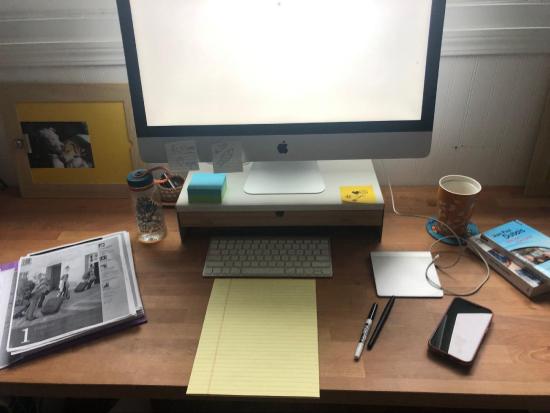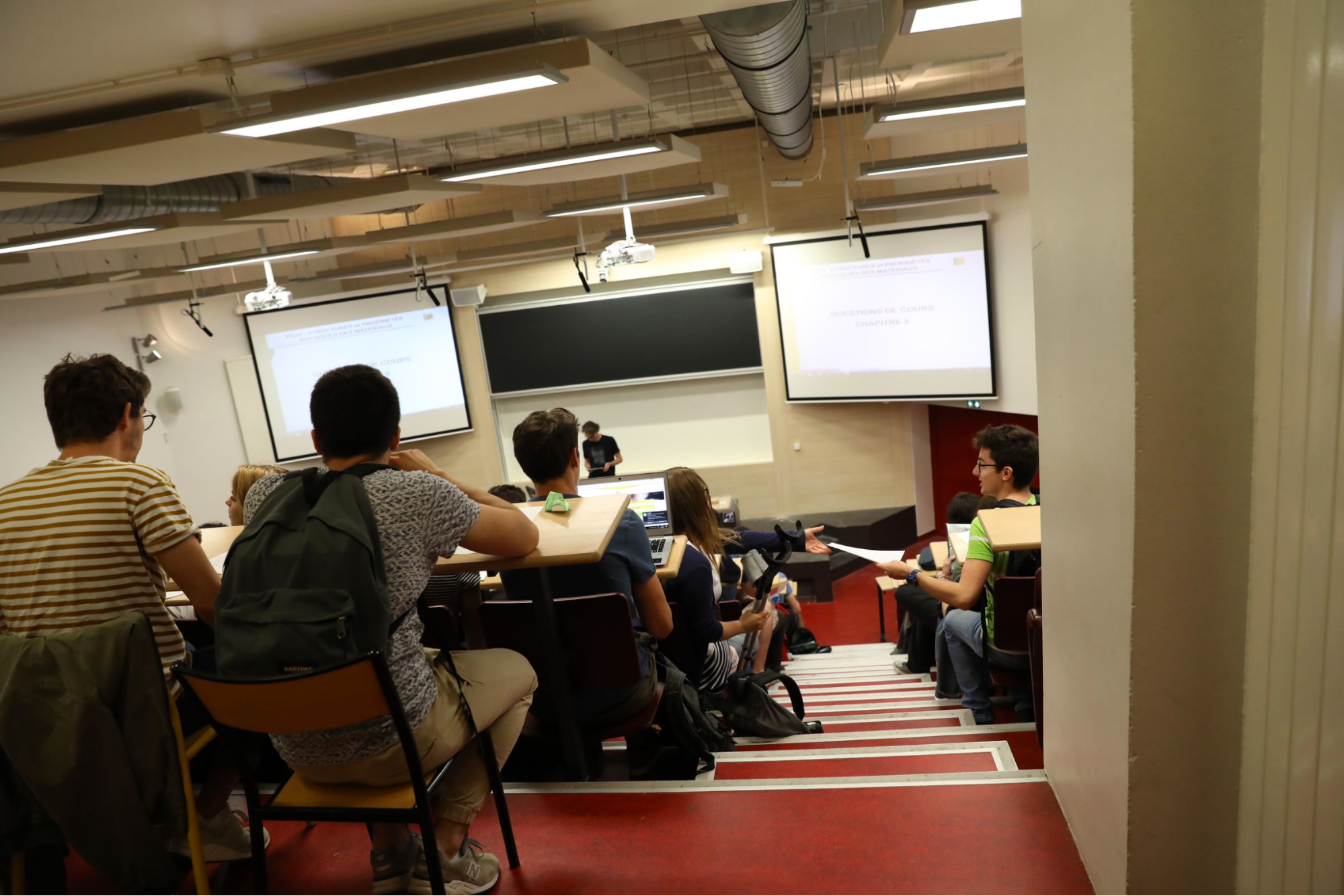1.7: On découvre - une salle de classe
- Page ID
- 257927
\( \newcommand{\vecs}[1]{\overset { \scriptstyle \rightharpoonup} {\mathbf{#1}} } \)
\( \newcommand{\vecd}[1]{\overset{-\!-\!\rightharpoonup}{\vphantom{a}\smash {#1}}} \)
\( \newcommand{\dsum}{\displaystyle\sum\limits} \)
\( \newcommand{\dint}{\displaystyle\int\limits} \)
\( \newcommand{\dlim}{\displaystyle\lim\limits} \)
\( \newcommand{\id}{\mathrm{id}}\) \( \newcommand{\Span}{\mathrm{span}}\)
( \newcommand{\kernel}{\mathrm{null}\,}\) \( \newcommand{\range}{\mathrm{range}\,}\)
\( \newcommand{\RealPart}{\mathrm{Re}}\) \( \newcommand{\ImaginaryPart}{\mathrm{Im}}\)
\( \newcommand{\Argument}{\mathrm{Arg}}\) \( \newcommand{\norm}[1]{\| #1 \|}\)
\( \newcommand{\inner}[2]{\langle #1, #2 \rangle}\)
\( \newcommand{\Span}{\mathrm{span}}\)
\( \newcommand{\id}{\mathrm{id}}\)
\( \newcommand{\Span}{\mathrm{span}}\)
\( \newcommand{\kernel}{\mathrm{null}\,}\)
\( \newcommand{\range}{\mathrm{range}\,}\)
\( \newcommand{\RealPart}{\mathrm{Re}}\)
\( \newcommand{\ImaginaryPart}{\mathrm{Im}}\)
\( \newcommand{\Argument}{\mathrm{Arg}}\)
\( \newcommand{\norm}[1]{\| #1 \|}\)
\( \newcommand{\inner}[2]{\langle #1, #2 \rangle}\)
\( \newcommand{\Span}{\mathrm{span}}\) \( \newcommand{\AA}{\unicode[.8,0]{x212B}}\)
\( \newcommand{\vectorA}[1]{\vec{#1}} % arrow\)
\( \newcommand{\vectorAt}[1]{\vec{\text{#1}}} % arrow\)
\( \newcommand{\vectorB}[1]{\overset { \scriptstyle \rightharpoonup} {\mathbf{#1}} } \)
\( \newcommand{\vectorC}[1]{\textbf{#1}} \)
\( \newcommand{\vectorD}[1]{\overrightarrow{#1}} \)
\( \newcommand{\vectorDt}[1]{\overrightarrow{\text{#1}}} \)
\( \newcommand{\vectE}[1]{\overset{-\!-\!\rightharpoonup}{\vphantom{a}\smash{\mathbf {#1}}}} \)
\( \newcommand{\vecs}[1]{\overset { \scriptstyle \rightharpoonup} {\mathbf{#1}} } \)
\( \newcommand{\vecd}[1]{\overset{-\!-\!\rightharpoonup}{\vphantom{a}\smash {#1}}} \)
\(\newcommand{\avec}{\mathbf a}\) \(\newcommand{\bvec}{\mathbf b}\) \(\newcommand{\cvec}{\mathbf c}\) \(\newcommand{\dvec}{\mathbf d}\) \(\newcommand{\dtil}{\widetilde{\mathbf d}}\) \(\newcommand{\evec}{\mathbf e}\) \(\newcommand{\fvec}{\mathbf f}\) \(\newcommand{\nvec}{\mathbf n}\) \(\newcommand{\pvec}{\mathbf p}\) \(\newcommand{\qvec}{\mathbf q}\) \(\newcommand{\svec}{\mathbf s}\) \(\newcommand{\tvec}{\mathbf t}\) \(\newcommand{\uvec}{\mathbf u}\) \(\newcommand{\vvec}{\mathbf v}\) \(\newcommand{\wvec}{\mathbf w}\) \(\newcommand{\xvec}{\mathbf x}\) \(\newcommand{\yvec}{\mathbf y}\) \(\newcommand{\zvec}{\mathbf z}\) \(\newcommand{\rvec}{\mathbf r}\) \(\newcommand{\mvec}{\mathbf m}\) \(\newcommand{\zerovec}{\mathbf 0}\) \(\newcommand{\onevec}{\mathbf 1}\) \(\newcommand{\real}{\mathbb R}\) \(\newcommand{\twovec}[2]{\left[\begin{array}{r}#1 \\ #2 \end{array}\right]}\) \(\newcommand{\ctwovec}[2]{\left[\begin{array}{c}#1 \\ #2 \end{array}\right]}\) \(\newcommand{\threevec}[3]{\left[\begin{array}{r}#1 \\ #2 \\ #3 \end{array}\right]}\) \(\newcommand{\cthreevec}[3]{\left[\begin{array}{c}#1 \\ #2 \\ #3 \end{array}\right]}\) \(\newcommand{\fourvec}[4]{\left[\begin{array}{r}#1 \\ #2 \\ #3 \\ #4 \end{array}\right]}\) \(\newcommand{\cfourvec}[4]{\left[\begin{array}{c}#1 \\ #2 \\ #3 \\ #4 \end{array}\right]}\) \(\newcommand{\fivevec}[5]{\left[\begin{array}{r}#1 \\ #2 \\ #3 \\ #4 \\ #5 \\ \end{array}\right]}\) \(\newcommand{\cfivevec}[5]{\left[\begin{array}{c}#1 \\ #2 \\ #3 \\ #4 \\ #5 \\ \end{array}\right]}\) \(\newcommand{\mattwo}[4]{\left[\begin{array}{rr}#1 \amp #2 \\ #3 \amp #4 \\ \end{array}\right]}\) \(\newcommand{\laspan}[1]{\text{Span}\{#1\}}\) \(\newcommand{\bcal}{\cal B}\) \(\newcommand{\ccal}{\cal C}\) \(\newcommand{\scal}{\cal S}\) \(\newcommand{\wcal}{\cal W}\) \(\newcommand{\ecal}{\cal E}\) \(\newcommand{\coords}[2]{\left\{#1\right\}_{#2}}\) \(\newcommand{\gray}[1]{\color{gray}{#1}}\) \(\newcommand{\lgray}[1]{\color{lightgray}{#1}}\) \(\newcommand{\rank}{\operatorname{rank}}\) \(\newcommand{\row}{\text{Row}}\) \(\newcommand{\col}{\text{Col}}\) \(\renewcommand{\row}{\text{Row}}\) \(\newcommand{\nul}{\text{Nul}}\) \(\newcommand{\var}{\text{Var}}\) \(\newcommand{\corr}{\text{corr}}\) \(\newcommand{\len}[1]{\left|#1\right|}\) \(\newcommand{\bbar}{\overline{\bvec}}\) \(\newcommand{\bhat}{\widehat{\bvec}}\) \(\newcommand{\bperp}{\bvec^\perp}\) \(\newcommand{\xhat}{\widehat{\xvec}}\) \(\newcommand{\vhat}{\widehat{\vvec}}\) \(\newcommand{\uhat}{\widehat{\uvec}}\) \(\newcommand{\what}{\widehat{\wvec}}\) \(\newcommand{\Sighat}{\widehat{\Sigma}}\) \(\newcommand{\lt}{<}\) \(\newcommand{\gt}{>}\) \(\newcommand{\amp}{&}\) \(\definecolor{fillinmathshade}{gray}{0.9}\)Le vocabulaire utile: la salle de classe et les instructions.
1. On observe : une chaise, un stylo et des tablettes
** Potential ADAPT/H5P problem
Sur le bureau, il y a …
Step 1. Look at the picture and complete the following paragraph with the appropriate indefinite article: un, une, or des.
Sur le bureau, il y a _______ cahier et _______ stylo. Il y a aussi _______ livres et _______ stylos. Sur le bureau, il y a toujours (=always) _______ portable, _______ gourde et _______ post-its. Il n’y a pas de lunettes (=glasses).

Step 2. Look at the underlined elements:
un bureau, une carte, une chaise, une tablette, un ordinateur, un tableau
How would you translate the underlined elements in English?
What do you think the difference between un and une is related to?
Fill in the blanks:
|
un is used when the noun is |
|
|
une is used when the noun is |
Step 3. Look at the following pairs. What is the difference between the words in each pair?
un ordinateur / des ordinateurs une application / des applications
un cahier / des cahiers une chaise / des chaises un campus / des campus
Fill in the blanks:
|
des is used when the noun (masculine or feminine) is |
Step 4. Look at the last sentence : il n’y a pas de lunettes.
What do you notice?
Step 5. Qu’est-ce qu’il y a sur votre bureau et notez une chose qu’il n’y a pas.
|
Picture or drawing of your desk |
Sur mon bureau, il y a… - - - - Sur mon bureau, il n’y a pas de - |
2. On apprend
#Grammaire #LesArticlesIndéfinis
Cliquez ici, lisez les explications et complétez les activités : determiners: indefinite articles
3. On s’entraîne
A. C’est masculin ou féminin ?
** Potential ADAPT/H5P problem
Listen and decide if the following words are masculine or feminine.
|
masculin |
féminin |
|
|
Modèle : You hear: une porte. |
|
|
|
1. |
|
|
|
2. |
|
|
|
3. |
|
|
|
4. |
|
|
|
5. |
|
|
|
6. |
|
|
|
7. |
|
|
|
8. |
|
|
B. C’est singulier ou pluriel ?
** Potential ADAPT/H5P problem
Listen and decide if the following words are singular or plural.
|
singulier |
pluriel |
|
|
Modèle : You hear: des cahiers. |
|
|
|
1. |
|
|
|
2. |
|
|
|
3. |
|
|
|
4. |
|
|
|
5. |
|
|
|
6. |
|
|
|
7. |
|
|
|
8. |
|
|
C. On écoute et on écrit : #dictogloss
** Potential ADAPT/H5P problem
Step 1. Working in small groups, read through the text first and predict the words that you expect to be in the blanks. Then listen as your instructor reads a dialogue between Mme Luminita and her students and reconstruct the text with as many details as possible.
Le vocabulaire utile : les instructions
|
Mme Luminita : Bonjour. Quelle est aujourd’hui ? |
|
Étudiant / Étudiante :C’est 1er septembre ! |
|
Mme Luminita : ! Maintenant, vos livres |
|
Étudiant / Étudiante : À quelle page, Madame ? |
|
Mme Luminita : Ah... . Écoutez bien et sur une feuille. Dans mon il y a un livre et ___________ . |
|
Étudiant / Étudiante : Excusez-moi, , que veut dire “livre” ? |
|
Mme Luminita : Un livre c’est book en anglais. |
|
On continue, il y a aussi et des lunettes 👓. À vous, qu’est-ce qu’il y a dans votre ? |
Step 2. Now, compare the two sentences:
Il y a des lunettes dans le sac / There are sunglasses in the bag
What do you notice about the bolded sections in these two sentences?
Step 3.
#Grammaire #Voilà
Cliquez ici, lisez les explications et complétez les activités : voilà vs. il y a
Step 4. Répondez aussi à la question de Mme Luminita: qu’est-ce qu’il y a dans votre sac à dos et notez une chose qu’il n’y a pas.
|
|
Dans mon sac à dos, il y a… - - - - Dans mon sac à dos, il n’y a pas de - |
E. Une salle de classe à Compiègne
** Potential ADAPT/H5P problem

"File:Université de Technologie de Compiègne - amphi cours magistral tableaux.jpg" by Basile Morin is licensed under CC BY-SA 4.0
Step 1. Voici la photo d’un amphi (amphithéâtre) d’un cours magistral (=lecture) à l’université de Technologie de Compiègne. Où est Compiègne ?
Step 2. Write the names of at least three objects or people that you see in the picture. Remember to add the appropriate indefinite article: un, une, or des.
Sur la photo, Il y a ……
|
1. 2. 3. |
Step 3. Compare the classroom above to a typical classroom where you live. What is similar or different? Compare your list with a partner and find at least 1 person with 2 similar items.
4. On traduit
** Potential ADAPT/H5P problem
En français, comment dit-on ?
|
In English: |
En français : |
|
What’s your name? (asking a partner) |
|
|
How do you say ‘a notepad’? |
|
|
I don’t understand. |
|
|
Please repeat. |
|
|
Here is a book. |
|
|
The French book is on the desk. |
|
|
There are 20 students ? |
|
|
What does ‘autrice’ mean? |
|
|
Good night (to a friend as you leave) |
Ch 1 Devoirs 4



